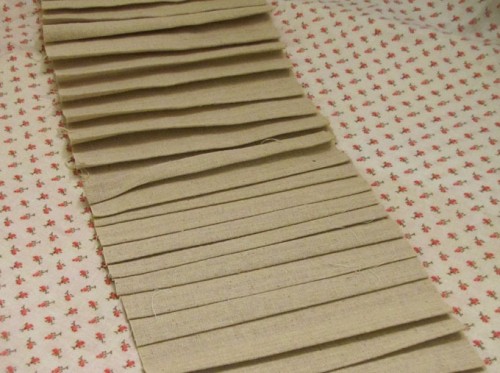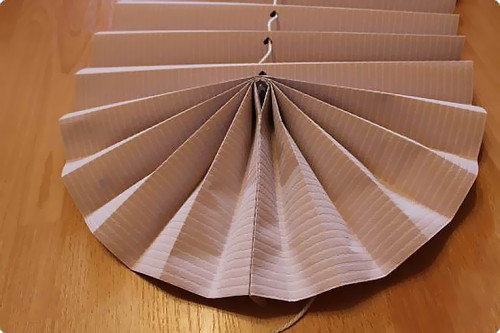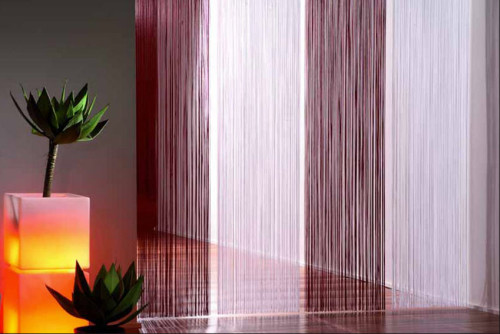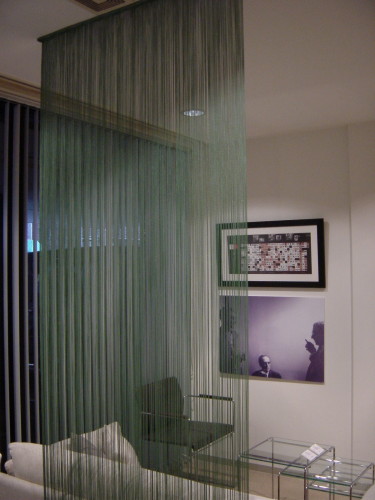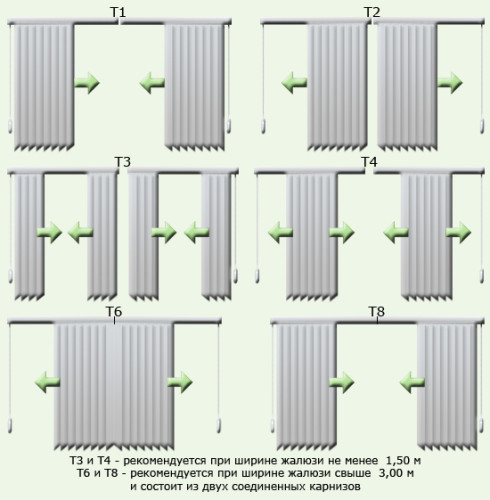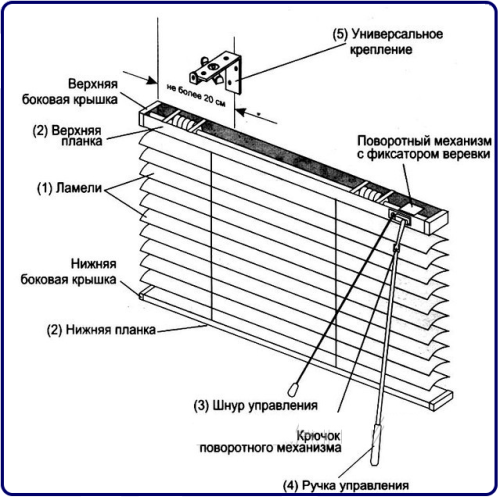Not enough money to buy blinds? Or do you want to imagine before the purchase how they will look on your windows? There is an option: make blinds on the windows with your own hands. We present you several options. They are selected from simple to complex.
Fluttered paper blinds
Thick wallpaper is ideal for this purpose: non -woven, for painting. If these are wallpaper for painting, then there is the opportunity to decorate the blinds with any patterns or drawings.
Necessary tools: stationery knife, linen rope (or satin ribbons), hole punch, double -sided tape, long ruler.
How to make blinds from wallpaper or thick paper:
- Cut the wallpaper. The width is the same as the width of the window, and the length of the percent by 20-40 is more than the required length of the blinds.
- Using a long ruler, fold a strip with an accordion. Try to make the steps of the accordion the same. It is advisable to mark in advance. The marking step is 3-5 cm. The first step on top should be folded in the pattern inward, and the last step of the blinds should be folded outward.
- Pierce the folded accordion in the middle. If at the bottom of the blinds you do not make a fan (look further), then it is advisable to pierce the holes and along the edges (5 cm from the edge) of the accordion. Another option: make holes only along the edges, but do not make in the middle. In general, to your taste. One nuance: the edges of the holes can be strengthened by gluing square or round (2*2 cm) pieces of paper or tape at each step in the place where there will be holes. This is especially true for the upper hole.
- Insert a rope or satin ribbons (the same or different colors) into the resulting hole. The length of the rope should be 30-40 cm longer than the height of the blinds.
- On the upper step, fix the rope with a knot and seal completely the entire step with tape.
- On the lower step, fix the rope with a lock (like laces on jackets). If you insert 2 or 3 ropes (ribbons), they can be fixed with separate clamps or collect all three ribbons into one latch.
- Spread the accordion.
- If you use 1 rope in the middle, it is advisable to glue the lower step (two halves of the step with each other). It will be like a fan. To do this, seal the half steps with tape, then connect with the second half.
- Glue the upper step with tape to the window. Do not forget to degrease the gluing place in advance.
If you do not want to mess with ropes and ribbons, use decorative clothespins to fix the blinds. The blinds of this kind are convenient in that if they are tired, faded or polluted, you can simply make new ones. Those who have metal blinds know how difficult it is to wash every strip. No matter how you wash the old blinds, it will still be seen that they are old. It’s a pity to throw it out, they cost a lot of money. And it’s not a pity to throw paper. The interior update is cheap and original.
Many will be interested in how to make a blind-cluss out of fabric. The technology is the same as for paper, but the fabric must be treated with gelatin. Process each bent pledge step with an iron.
Blinds from threads
Such blinds for manufacturing require much more time than blinds from wallpaper. But the result can become a masterpiece. How to make blinds on the windows using threads.
- For fastening threads (fishing line), take a wooden bar.
- String any small material to the threads (or on the fishing line).
- Fix the threads to the wooden bar.
The instruction may seem simple, but the execution of the second paragraph can take a lot of time. As a material for stringing, they are suitable:
- circus covers (plastic or cork);
- large beads (plastic, wood); You can string small, even beads, if you are not limited in time and like to develop fine motor skills;
- decorative figures (wood, dermatin, skin).
Great for stringing the blinds plastic tubes for cocktails are also perfect. They can be alternated with other elements: beads or wooden figures.
Useful advice, if you want to make distances between the elements: so that the details do not shift down, use the nodes on the threads before and after the part.
In principle, such blinds do not quite correspond to the purpose of the curtains: to open and close. They do not add up. Therefore, the curtains on the threads usually perform a decorative function and only the part of the window is closed, like lambrequins. Photos of blinds from threads can give an idea of \u200b\u200bpossible ideas and inspire you to create your works of art.
Vertical blinds
The basis for fixing the lamellas is again a wooden bar. Or a special cornice for curtains that can be purchased in a store. For narrow lamellas, it is convenient to use a cornice in the form of a pipe, and for wide lamella - a profile cornice with paths. As a material for lamellas, they are suitable:
- multi -colored silk ribbons;
- braids made of fabrics, dermatin, leather;
- all the same dense paper or wallpaper;
- curtain fabric; Lamels are made two -layer.
Such curtains can be folded and not afraid that small details strung on a fishing line, as in blinds from threads, are mixed up with each other. For wide lamellas, which will be suspended to a profile cornice, it is possible to make a mechanism for turning and folding.
How to make a blinds with a turning mechanism:
- The side edges of the lamellas can be treated with overlock, and the lower and upper ones are strengthened by wooden plates. The width of the lamella can be different, but 11-13 cm looks best.
- On the lamella at the top make fabric loops for hanging on hooks. Or screw metal hooks with threads into wooden plates (make sure that the hook is exactly in the middle).
- To fasten the rotary cord in the upper wooden plates, drill holes at a distance of 1.5 cm from the edge. The holes should be narrow.
- Put on the hole in the hole. At the same time, using glue, fix the length of the cord between the lamels. To determine the length of the cord between the lamels, lay them in parallel, closing 1-2 cm. If the hole is too wide, chips coated with glue can be used to compact and fix the cord. The cord should be a length of two window widths plus two heights of the window. A richen cord must form a ring.
- The lamellas are suspended to the guide profile cornice.
- The free part of the cord is suspended on threaded hooks on one side of the profile cornice. On the other hand, again, using a threaded hook, fix the cord so that when trying to turn the lamella, they do not begin to move along the cornice. Therefore, the extreme lamel will always be near this side. And the blinds will take shape only in this direction.
- From the long part of the control cord to the extreme lamel, attach the control rod. With its help, you will fold the blinds.
Horizontal blinds
The mechanism of turning the horizontal plates is quite complicated, so at home it is really possible to make blinds without a rotation system. How to make blinds with your own hands if the lamellas are located horizontally.
- Buy a profile cornice for curtains. The number of grooves for curtains will be determined by the width of the window. The window width is divided by 60 cm (the middle width of one luli section).
- Make frames from a thin beam. The frame width is 50-60 cm, the height from the profile to the windowsill or to the floor (the classic version of 15 cm from the floor). Fixed with metal corners in the joints. Color the frames in the color suitable for the color of the lamella.
- Cut stripes (lamellas) from fabric or thick paper. The width of the strips is 12-15 cm. The length of the strip should be 4 centimeters more than the width of the frame. These are allowances for bending over the edges of the frame during fastening. The number of lamellas is calculated by dividing the height of the frame into the average width of the lamella and the gap between them (1-2 cm). Based on the number of lamellas, calculate their width, while the width of the first and last lamella is more than the rest by 4 cm (allowance for bending). When calculating, do not forget that the intervals between lamellas will be 1 less than lamella. Before cutting strips from wallpaper for painting, apply a pattern. You can use the stencil.
- Stretch the lamellas and fix it on the frame. For consolidation, tape, glue or small nails-button are suitable.
- To hang sections into the upper end of the frame, screw hooks.
- High the frames on a profile cornice.
The blinds are ready. The only drawback of such blinds: they cannot be folded completely, the front section will always be in sight. Therefore, if you want to completely move the sections from the window opening, provide in advance for them a place near the window. Accordingly, this must be bought by a profile cornice: such a length that the loud sections can completely free the window opening.
Finally, we suggest you watch a video of how to make blinds at home.

